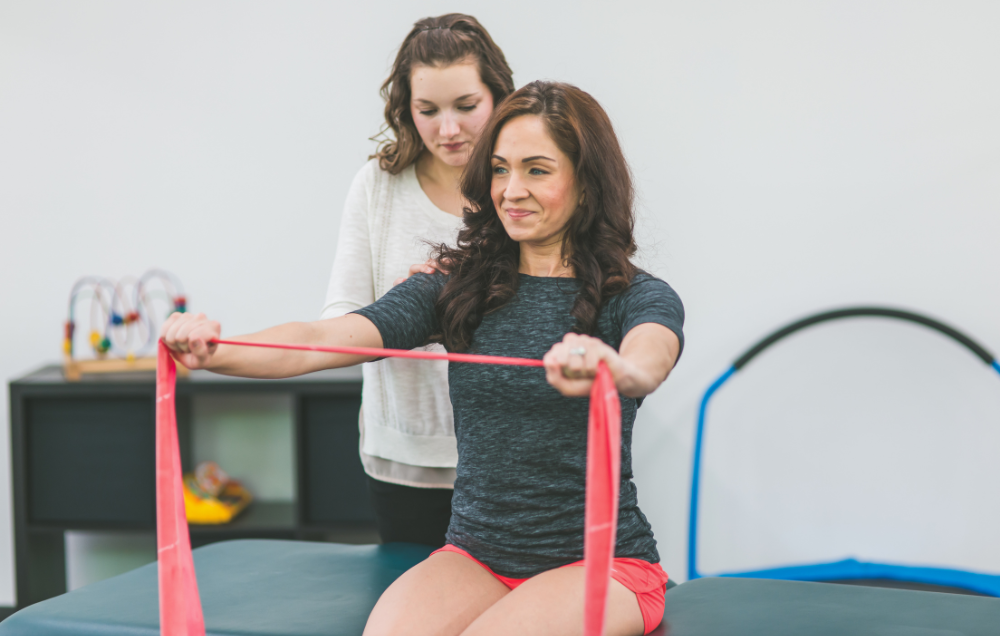Contents
A rotator cuff tear is a common injury with several possible causes. This injury often occurs in people who make repetitive shoulder motions. Athletes and manual laborers are at a heightened risk of rotator cuff tear for this reason. Depending on the injury’s severity, a rotator cuff tear can lead to symptoms that can be very serious. Painful symptoms and limited mobility can impact your daily activities. While mild symptoms can be treated with rest and pain medication, these may not be enough to ensure a speedy and complete recovery. Physical therapy for a rotator cuff tear is one treatment route that can yield great results. When deciding whether you need physical therapy, it is important to consider the signs of your current condition.
Signs you may need physical therapy for a rotator cuff tear
- Persistent shoulder pain — Rotator cuff tears are often painful injuries. If shoulder pain persists for an extended duration after the injury, it may be a sign of a severe rotator cuff tear. Persistent shoulder pain can be made worse during activities like reaching, lifting and throwing. Physical therapy for your rotator cuff tear can help alleviate this kind of pain. Techniques like manual therapy can mobilize the affected tissue to promote healing.
- Shoulder weakness — Does your shoulder feel weaker than it used to be? This could be a symptom of a rotator cuff tear. A rotator cuff tear can result in weakness in the affected shoulder, making everyday tasks difficult to perform. Physical therapy can help reduce shoulder weakness caused by rotator cuff tears. With exercises and specialized therapies targeting the shoulder, physical therapy aims to strengthen the muscles surrounding the shoulder joint. Strengthening these muscles can enhance shoulder stability over time.
- Limited range of motion — A rotator cuff tear can limit the range of motion in your arm and shoulder. You may have difficulty raising your arm fully without feeling pain or stiffness. Your ability to rotate your arm outward or inward can also be limited. If you are having difficulty moving your arm, it may be because of a rotator cuff tear. Physical therapy can focus on restoring range of motion by promoting healing around the affected joint.
- Shoulder instability — Many people suffering from rotator cuff tears report shoulder instability. This can feel like the shoulder joint is giving way or coming out of its socket. The feeling is sometimes described as a popping sensation. Your shoulder may also be prone to feelings of slipping or catching. All of these feelings can be signs of a rotator cuff tear.
- Difficulty sleeping — The symptoms listed above often lead to sleeping difficulties. Persistent pain is one common symptom that can make it challenging to have a restful night of sleep. If you sleep on your side, you may find it especially uncomfortable to sleep on the side of the injured shoulder. Difficulty sleeping can cause you to lose rest, which can affect the healing process. By addressing the underlying conditions contributing to your discomfort, physical therapy can help allow for more restful sleep.
- Other functional limitations — After an injury, completing daily tasks can be challenging. With a rotator cuff tear, weakness and inflexibility can limit your body’s functionality. If you are an athlete or someone who works with your hands, this can severely impact your ability to be productive. A shoulder injury can also prevent you from participating in active hobbies.
Advantages of using physical therapy for a rotator cuff tear
- Pain relief — Pain can be one of the hardest injury symptoms to tolerate. Intense shoulder pain can affect many aspects of your life, from work to just enjoying yourself. This is why a skilled physical therapy specialist will prioritize pain relief strategies. Various techniques such as manual therapy and targeted exercise can help reduce shoulder pain and inflammation.
- Muscle strengthening — Physical therapy can help address the symptoms and causes of a rotator cuff tear. One way it can do this is through muscle strengthening techniques. By strengthening the muscles that support the shoulder, you can improve stability and enhance general shoulder function.
- Functional recovery — One of the primary end goals of physical therapy is restoring functionality. Shoulder recovery means you can return to active participation in many different aspects of life. Physical therapy can help ensure that you can perform daily activities in a safe and efficient way. In addition to recovery, physical therapy can help prevent future injuries.
Lattimore Physical Therapy can help address your rotator cuff tear
Need physical therapy for your rotator cuff tear? Lattimore Physical Therapy is here to help. We want our patients to have a productive and enjoyable physical therapy experience. Our physical therapists bring a positive attitude to physical therapy with each patient. When you choose Lattimore PT to address your rotator cuff injury, you can look forward to each great session on the path to recovery.
Contact our team today for more information on rotator cuff tear treatments or to schedule an initial appointment.


